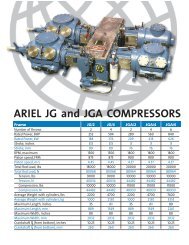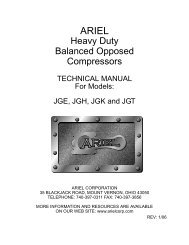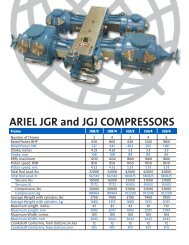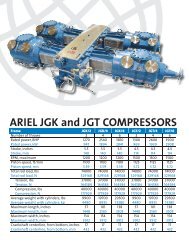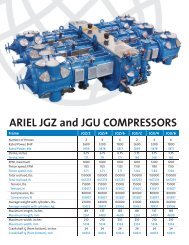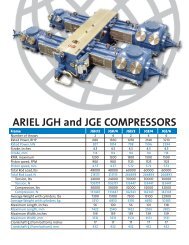Heavy Duty Balanced Opposed Compressors
Heavy Duty Balanced Opposed Compressors
Heavy Duty Balanced Opposed Compressors
You also want an ePaper? Increase the reach of your titles
YUMPU automatically turns print PDFs into web optimized ePapers that Google loves.
FOR MODELS: JG AND JGA SECTION 4 - LUBRICATION AND VENTING<br />
gummy deposits which can be found in the distance piece, packing case, cylinder and<br />
valves are indicators of under lubrication.<br />
Excessive (over) lubrication can result in excessive oil carryover into the gas stream, and<br />
increased quantities of deposits in the valves and gas passages. Valve plate breakage and<br />
packing failure are also symptoms of over lubrication. The packing case will “hydraulic”,<br />
which forces the packing rings to lift off of the rod enough to form a leak path. Increased gas<br />
leakage then results in packing and rod overheating. A rod and packing case can turn blue<br />
even though the lubrication appears sufficient.<br />
Even when the proper rate and lubricating medium are in use, dirt and foreign matter in the<br />
gas will prevent the lubricant from performing properly. Inlet gas debris screens with a maximum<br />
50 micron opening are recommended. Proper maintenance of the inlet screens is<br />
required.<br />
To check cylinders for the proper lubrication rates, the cigarette paper test method can provide<br />
a practical indication. Relieve and vent all pressure from all cylinders. Remove a head<br />
end suction valve and position piston at inner center, for the cylinder to be checked. “Lock<br />
out” so that crankshaft can not be accidentally turned; see the “CAUTION” in “General Introduction”<br />
on page 5-1 and refer to the Packager’s Operation Manual for details. Use two layers<br />
of regular unwaxed commercial cigarette paper, together. Wipe the cylinder bore at top<br />
with both papers using light pressure in circumferential motion through about 20°. The paper<br />
next to the bore should be stained (wetted with oil), but the second paper should not be<br />
soaked through.<br />
Repeat the test at both sides of the bore at about 90° from the top, using two new clean<br />
papers for each side. When the paper next to the bore is not stained through, it may be an<br />
indication of under lubrication. When both papers are stained through, it may be an indication<br />
of over lubrication. In either case, it is normally recommended that the lubrication rate<br />
be changed accordingly and that all cigarette paper tests be repeated until passed. Repeat<br />
for all cylinders. If a reduction or increase of the lubrication rate is indicated for a cylinder,<br />
change in 5% increments by adjusting cycle time at the force feed lube pump as discussed<br />
in “Force Feed Lubricator Adjustment” on page 3-8. Repeat oil film testing, for the cylinders<br />
affected, after 24 hours of operation.<br />
NOTE: THE CIGARETTE PAPER TEST ONLY GIVES AN INDICATION OF OIL FILM<br />
QUANTITY. IT DOES NOT GIVE AN INDICATION OF VISCOSITY QUALITY.<br />
OILS DILUTED WITH WATER, HYDROCARBONS OR OTHER CONSTITUENTS<br />
MAY PRODUCE WHAT APPEARS TO BE AN ADEQUATE FILM. BUT THE OIL<br />
FILM MAY NOT HAVE THE REQUIRED LOAD-CARRYING CAPABILITY DUE<br />
TO THE DILUTION.<br />
When observed symptoms indicate lack of lubrication; first verify that the force feed lubricator<br />
pumps are operating properly. Confirm that the distribution block cycle time matches the<br />
lube sheet or lubrication box information plate provided by Ariel, and double check that all<br />
tubing and fittings are tight and no leaks are present. Do not overlook the fittings inside the<br />
cylinder gas passages.<br />
The lubricant flow rates (measured in seconds per cycle) are generally so low that all of the<br />
required flow to a lube point may be observed as a drip at a fitting. The break-in and normal<br />
lube timing rates which are stamped on the lubricator box information plate are calculated<br />
according to the Ariel Lube Specifications to match the gas operation conditions as supplied<br />
to Ariel with the compressor order. The lube sheets supplied in the Ariel Parts Book state<br />
PAGE 4 - 6 11/01





